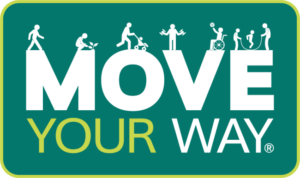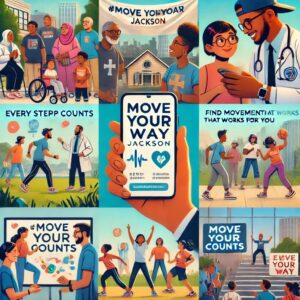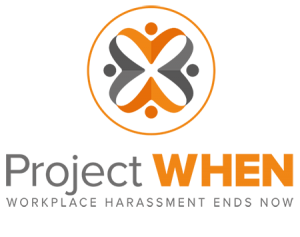How the Mississippi State Department of Health ‘Move Your Way’ Campaign in Jackson, Mississippi Successfully Communicated the Importance of Physical Activity
 The Mississippi State Department of Health (MSDH) has long been dedicated to enhancing the well-being of its residents. MSDH collaborated with the Office of Disease Prevention and Health Promotion (ODPHP) to implement the “Move Your Way®” campaign in Jackson, aiming to encourage residents to incorporate more physical activity into their daily routines through effective communication and outreach strategies.
The Mississippi State Department of Health (MSDH) has long been dedicated to enhancing the well-being of its residents. MSDH collaborated with the Office of Disease Prevention and Health Promotion (ODPHP) to implement the “Move Your Way®” campaign in Jackson, aiming to encourage residents to incorporate more physical activity into their daily routines through effective communication and outreach strategies.
This case study explores how Jackson effectively communicated the benefits of movement and empowered residents to take charge of their health through strategic outreach and engagement.
The “Move Your Way” Campaign: Effective Health Communication for Behavior Change
The “Move Your Way®” campaign translates the Physical Activity Guidelines for Americans into practical, easy-to-understand advice for individuals and families. In Jackson, the campaign focused on clear and engaging communication strategies to reach low-income families and African American residents, emphasizing that all types of movement count and promoting small, manageable steps toward increased physical activity.
By recognizing the unique challenges faced by the community—such as limited access to safe walking areas, financial constraints for gym memberships, and a lack of awareness about simple movement options—the campaign crafted messaging that resonated with residents and motivated them to take action.
Key Communication Strategies and Activities
1. Building Strong Community Partnerships to Amplify Messaging
One of the key pillars of the campaign’s success was collaboration with trusted local organizations to reinforce messaging.
- Partnerships with Local Institutions – The campaign collaborated with the American Heart Association, Mississippi Business Group on Health, Jackson Heart Study, local hospitals, and faith-based organizations to extend reach.
- Using Community Leaders as Trusted Messengers – The campaign leveraged local health advocates, church leaders, and educators to communicate the benefits of physical activity in ways that felt authentic and relatable.
- Multi-Channel Messaging – Campaign materials were shared through community centers, healthcare facilities, and neighborhood networks to ensure wide distribution.
Why This Worked: By involving organizations that residents already trusted, the campaign ensured that its messages were received with credibility and impact.
2. Engaging the Community with Events and Interactive Communication
The campaign didn’t just tell people to be active—it engaged them in conversation and created opportunities for movement.
- Kickoff Event with Interactive Stations: The campaign launch included interactive booths where residents could learn about easy movement exercises, participate in live demonstrations, and receive personalized physical activity plans.
- Community Listening Sessions: Before launching the campaign, MSDH hosted listening sessions to understand the barriers residents faced in staying active, shaping the messaging accordingly.
- Local Radio and Town Halls: The campaign used radio segments and community town halls to answer residents’ questions and address concerns about incorporating movement into daily life.
- Feedback Loops: Surveys and social media polls allowed residents to share their thoughts on what messaging resonated most with them.
Why This Worked: By making health communication a two-way street, the campaign ensured that residents felt heard and that messaging was tailored to their needs.
3. Digital and Social Media Strategy for Widespread Engagement
A strong digital presence was essential to reinforce campaign messaging and encourage continuous engagement.
- Social Media Engagement: The campaign launched the #MoveYourWayJackson hashtag to encourage residents to share their movement activities and engage with others.
- Short-Form Videos and Testimonials: Engaging video content featured real residents sharing their movement journeys, making the campaign relatable and inspiring.
- Targeted Digital Ads: Geo-targeted advertisements ensured that messaging reached key demographics who might benefit most from increased physical activity.
- SMS and Email Reminders: Residents received weekly motivation tips and reminders to stay active, reinforcing campaign messaging beyond the initial engagement.
Why This Worked: Social media and digital communication kept the campaign alive beyond in-person events, maintaining momentum and motivation.
4. Inclusive and Accessible Messaging for All Residents
Ensuring that campaign communication was inclusive and accessible was critical to reaching Jackson’s diverse population.
- Bilingual and Culturally Relevant Materials: Messaging was available in English and Spanish, ensuring accessibility for non-English speakers.
- Tailored Communication for Different Age Groups: The campaign used youth-friendly visuals for younger audiences, straightforward instructions for seniors, and workplace-focused materials for busy professionals.
- Simple, Actionable Messaging: Instead of overwhelming residents with fitness jargon, the campaign emphasized, “Every step counts” and “Find movement that works for you.”
Why This Worked: Clear, inclusive, and culturally relevant communication ensured that all community members could engage with and benefit from the campaign.
5. Leveraging Healthcare Providers and Employers for Message Reinforcement
To further integrate movement into daily routines, the campaign collaborated with doctors, employers, and schools.
- Doctor-Recommended Movement Plans: Healthcare providers distributed personalized movement plans to patients, reinforcing the campaign’s messaging in clinical settings.
- Workplace Wellness Campaigns: Employers were encouraged to implement “active breaks,” walking meetings, and step challenges.
- School-Based Movement Initiatives: The campaign worked with local schools to incorporate physical activity into classroom routines and after-school programs.
Why This Worked: Embedding physical activity messaging within existing institutions helped normalize movement as part of daily life.
Campaign Outcomes and Impact
The “Move Your Way®” campaign successfully increased awareness about physical activity and encouraged behavioral change in Jackson.
- Increase in Community Engagement: Surveys showed that residents felt more informed and motivated to move after interacting with campaign messaging.
- Growth in Social Media Interaction: The #MoveYourWayJackson hashtag gained significant traction, with thousands of posts showcasing movement activities.
- Higher Participation in Local Fitness Programs: Walking groups and fitness classes saw increased attendance.
- Continued Partnerships for Long-Term Health Communication: Many of the organizations involved continued promoting movement initiatives beyond the campaign’s official timeline.
Key Takeaways for Health Communication Campaigns
1. Authentic, Relatable Messaging Increases Engagement
People connect with stories, not statistics. Real-life testimonials and community-driven messaging made the campaign effective. ✅ Lesson: Use personal stories and trusted voices to communicate health messages.
2. Multi-Channel Communication Expands Reach
A successful health campaign requires both digital and traditional communication methods. ✅ Lesson: Blend online, offline, and grassroots engagement for maximum impact.
3. Interactive and Two-Way Communication Strengthens Engagement
Listening sessions, town halls, and social media engagement made the campaign a community conversation rather than a one-way message. ✅ Lesson: Engage communities in dialogue to ensure messaging resonates.
4. Inclusivity and Accessibility Enhance Impact
Ensuring materials are bilingual, culturally relevant, and tailored to different groups improves campaign success. ✅ Lesson: Design communication strategies that cater to diverse communities.
5. Sustained Messaging Builds Long-Term Change
One-time efforts fade; continuous engagement leads to lasting behavior change. ✅ Lesson: Plan for ongoing communication and reinforcement beyond the campaign timeline.
Conclusion: Effective Communication Drives Health Behavior Change
Jackson’s “Move Your Way®” campaign demonstrates how strategic communication can inspire lasting physical activity habits. By leveraging community partnerships, digital engagement, and interactive messaging, the campaign effectively encouraged movement and improved public health outcomes.
For other cities looking to promote wellness, this campaign serves as a model for using communication as a powerful tool to create meaningful, long-term behavioral change.
Ready to Elevate Your Agency’s Public Communication?
We understand the unique challenges state and local government agencies face—from complex issues to diverse community needs. Our comprehensive approach can help you transform the way you connect with constituents, improve transparency, and highlight the valuable work your agency does every day.
Interested in learning more? Reach out to us today for a consultation. We’d love to discuss how our services can support your goals and help you build lasting trust with the communities you serve.






